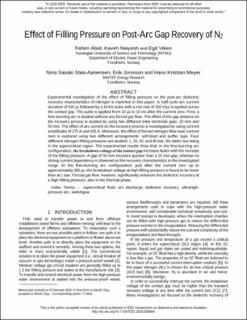| dc.description.abstract | Experimental investigation of the effect of filling pressure on the post-arc dielectric recovery characteristics of nitrogen is reported in this paper. A half-cycle arc current duration of 540 μs followed by a 10 kV pulse with a rise rate of 150 V/μs is applied across the contact gap. The pulse is applied from 10 μs to 10 ms after the current zero. First, a free-burning arc is studied without any forced gas flow. The effect of the gap distance on the recovery process is studied by using two different inter-electrode gaps: 20 mm and 50 mm. The effect of arc current on the recovery process is investigated by using current amplitudes of 275 A and 425 A. Moreover, the effect of forced nitrogen flow near current zero is explored using two different arrangements: self-blast and puffer type. Four different nitrogen filling pressures are studied: 1, 20, 40, and 80 bar, the latter two being in the supercritical region. The experimental results show that, in the free-burning arc configuration, the breakdown voltage of the contact gap increases faster with the increase of the filling pressure. A gap of 50 mm recovers quicker than a 20 mm gap, whereas no strong current dependency is observed on the recovery characteristics in the investigated range. In the free-burning arc configuration, just after the current zero up to approximately 300 μs, the breakdown voltage at high filling pressure is found to be lower than at 1 bar. Forced gas flow, however, significantly enhances the dielectric recovery at a high filling pressure, also in the thermal phase. | en_US |
